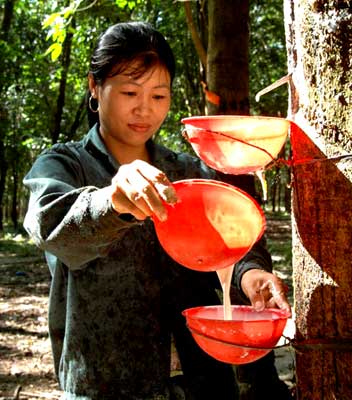
| Rubber industry to work with regional growers to boost exports | |
The Vietnam Rubber Association plans to share information with its counterparts in China’s main rubber suppliers to prevent over-supplies and close price gaps between the exporters. The agreement with Thailand, Indonesia and Malaysia will facilitate the exchange of information on output, demand and prices, said Tran Thi Thuy Hoa, the association’s general secretary. Vietnam’s rubber exports to China are currently cheaper than those from the three countries. While Vietnam exports rubber latex to 61 countries and territories, including the European Union and Japan, China is the main consumer of Vietnamese rubber, importing nearly 70 percent of the country’s total export volume, according to Hoa.
Of the country’s 208 rubber exporters, 165 companies trade with China, Hoa said, adding that 59 percent of Vietnam’s rubber exports to China are delivered under DAF (Delivered at Frontier) terms. The remaining volume is exported by sea or train.
She said the cooperation between Vietnam and the three other rubber suppliers would support Vietnamese rubber exporters, which have been hit hard by Chinese trade barriers since March this year.
China’s new regulations stipulate that Vietnam’s cross-border exports can only be conducted via Mong Cai or Luc Lam border gates in northern province of Quang Ninh and payments must be made via banks, not in cash as before.
Experts said Vietnamese rubber exporters should ship to other markets outside China, advising them not to “put all their eggs into one basket” as such a move could be risky if China were to change trade policies. But only large and experienced rubber firms have found other foreign consumers. Small enterprises prefer exporting to China as it is their traditional market.
Tay Ninh Rubber Joint-Stock Co., the nation’s second-largest listed rubber product maker, is one of the few companies whose businesses have not been affected by China’s new regulations as the firm exports mainly to the EU, Russia, Japan, the US, South Korea, Indonesia, and Turkey.
Trinh Van Vinh, chairman of the company, said it has recently penetrated the Indian market as well. But companies wanting to export to more demanding markets would have to invest in quality as Vinh said Tay Ninh’s high-quality latex has been exported for prices 17-25 percent higher than other kinds of latex sold to China.
Around the world
Rubber on Monday (10 Aug 2009) climbed by as much as 3 percent after China’s passenger-vehicle sales in July posted the largest gain in three years, boosting speculation demand will increase for the commodity used in tires, Bloomberg reported.
Futures in Tokyo advanced after falling 1.8 percent last week, the first decline in five weeks. In the first six months of this year, Vietnam exported 246,000 tons of latex worth USD 357 million. Exports to China in the period increased 6.3 percent year-on-year to USD 234 million, according to the Ministry of Industry and Trade.
China consumes more than 2.5 million tons of latex each year, accounting for 26 percent of the global demand. However, the country only produces 500,000 tons per year and imports the rest. Vietnam is the world’s fourth-largest rubber producer and the crop is among its largest agricultural exports after rice and coffee. Thailand, Indonesia and Malaysia are the top three growers. | |
| SGTT |
